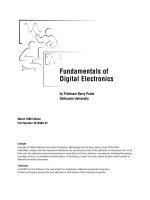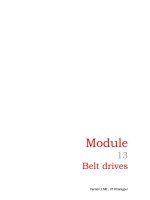Fundamentals of WiMAX (P1)
Bạn đang xem bản rút gọn của tài liệu. Xem và tải ngay bản đầy đủ của tài liệu tại đây (291.84 KB, 30 trang )
Praise for Fundamentals of WiMAX
This book is one of the most comprehensive books I have reviewed … it is a must
read for engineers and students planning to remain current or who plan to pursue a
career in telecommunications. I have reviewed other publications on WiMAX and
have been disappointed. This book is refreshing in that it is clear that the authors
have the in-depth technical knowledge and communications skills to deliver a logi-
cally laid out publication that has substance to it.
—Ron Resnick, President, WiMAX Forum
This is the first book with a great introductory treatment of WiMAX technology. It
should be essential reading for all engineers involved in WiMAX. The high-level
overview is very useful for those with non-technical background. The introductory
sections for OFDM and MIMO technologies are very useful for those with imple-
mentation background and some knowledge of communication theory. The chapters
covering physical and MAC layers are at the appropriate level of detail. In short, I
recommend this book to systems engineers and designers at different layers of the
protocol, deployment engineers, and even students who are interested in practical
applications of communication theory.
—Siavash M. Alamouti, Chief Technology Officer, Mobility Group, Intel
This is a very well-written, easy-to-follow, and comprehensive treatment of WiMAX.
It should be of great interest.
—Dr. Reinaldo Valenzuela, Director of Wireless Research, Bell Labs
Fundamentals of WiMAX is a comprehensive guide to WiMAX from both industry
and academic viewpoints, which is an unusual accomplishment. I recommend it to
anyone who is curious about this exciting new standard.
—Dr. Teresa Meng, Professor, Stanford University,
Founder and Director, Atheros Communications
Andrews, Ghosh, and Muhamed have provided a clear, concise, and well-written text
on 802.16e/WiMAX. The book provides both the breadth and depth to make sense of
the highly complicated 802.16e standard. I would recommend this book to both devel-
opment engineers and technical managers who want an understating of WiMAX and
insight into 4G modems in general.
—Paul Struhsaker, VP of Engineering, Chipset platforms, Motorola Mobile Device
Business Unit, former vice chair of IEEE 802.16 working group
Fundamentals of WiMAX is written in an easy-to-understand tutorial fashion. The
chapter on multiple antenna techniques is a very clear summary of this important
technology and nicely organizes the vast number of different proposed techniques into
a simple-to-understand framework.
—Dr. Ender Ayanoglu, Professor, University of California, Irvine,
Editor-in-Chief, IEEE Transactions on Communications
Fundamentals of WiMAX is a comprehensive examination of the 802.16/WiMAX
standard and discusses how to design, develop, and deploy equipment for this wire-
less communication standard. It provides both insightful overviews for those want-
ing to know what WiMAX is about and comprehensive, in-depth chapters on
technical details of the standard, including the coding and modulation, signal pro-
cessing methods, Multiple-Input Multiple-Output (MIMO) channels, medium
access control, mobility issues, link-layer performance, and system-level perfor-
mance.
—Dr. Mark C. Reed, Principle Researcher, National ICT Australia,
Adjunct Associate Professor, Australian National University
This book is an excellent resource for any engineer working on WiMAX systems.
The authors have provided very useful introductory material on broadband wireless
systems so that readers of all backgrounds can grasp the main challenges in
WiMAX design. At the same time, the authors have also provided very thorough
analysis and discussion of the multitudes of design options and engineering trade-
offs, including those involved with multiple antenna communication, present in
WiMax systems, making the book a must-read for even the most experienced wire-
less system designer.
—Dr. Nihar Jindal, Assistant Professor, University of Minnesota
This book is very well organized and comprehensive, covering all aspects of WiMAX
from the physical layer to the network and service aspects. The book also includes
insightful business perspectives. I would strongly recommend this book as a must-
read theoretical and practical guide to any wireless engineer who intends to investi-
gate the road to fourth generation wireless systems.
—Dr. Yoon Chae Cheong, Vice President, Communication Lab, Samsung
The authors strike a wonderful balance between theoretical concepts, simulation per-
formance, and practical implementation, resulting in a complete and thorough expo-
sition of the standard. The book is highly recommended for engineers and managers
seeking to understand the standard.
—Dr. Shilpa Talwar, Senior Research Scientist, Intel
Fundamentals of WiMAX is a comprehensive guide to WiMAX, the latest frontier
in the communications revolution. It begins with a tutorial on 802.16 and the key
technologies in the standard and finishes with a comprehensive look at the pre-
dicted performance of WiMAX networks. I believe readers will find this book
invaluable whether they are designing or testing WiMAX systems.
—Dr. James Truchard, President, CEO and Co-Founder, National Instruments
This book is a must-read for engineers who want to know WiMAX fundamentals
and its performance. The concepts of OFDMA, multiple antenna techniques, and
various diversity techniques—which are the backbone of WiMAX technology—are
explained in a simple, clear, and concise way. This book is the first of its kind.
—Amitava Ghosh, Director and Fellow of Technical Staff, Motorola
Andrews, Ghosh, and Muhamed have written the definitive textbook and reference
manual on WiMAX, and it is recommended reading for engineers and managers
alike.
—Madan Jagernauth, Director of WiMAX Access Product Management, Nortel
This page intentionally left blank
Fundamentals of WiMAX
Prentice Hall Communications Engineering
and Emerging Technologies Series
Theodore S. Rappaport, Series Editor
D
I
B
ENEDETTO
& G
IANCOLA
Understanding Ultra Wide Band Radio Fundamentals
D
OSTERT
Powerline Communications
D
URGIN
Space–Time Wireless Channels Technologies, Standards, and QoS
G
ARG
Wireless Network Evolution: 2G to 3G
G
ARG
IS-95 CDMA and cdma2000: Cellular/PCS Systems Implementation
L
IBERTI
& R
APPAPORT
Smart Antennas for Wireless Communications: IS-95 and Third Generation
CDMA Applications
M
URTHY
& M
ANOJ
Ad Hoc Wireless Networks: Architectures and Protocols
N
EKOOGAR
Ultra-Wideband Communications: Fundamentals and Applications
P
AHLAVAN
& K
RISHNAMURTHY
Principles of Wireless Networks: A Unifi ed Approach
P
ATTA N
Robust Modulation Methods and Smart Antennas in Wireless Communication
R
ADMANESH
Radio Frequency and Microwave Electronics Illustrated
R
APPAPORT
Wireless Communications: Principles and Practice, Second Edition
R
EED
Software Radio: A Modern Approach to Radio Engineering
R
EED
An Introduction to Ultra Wideband Communication Systems
S
KLAR
Digital Communications: Fundamentals and Applications, Second Edition
S
TARR
, S
ORBARA
, C
IOFFI
, & S
ILVERMAN
DSL Advances
T
RANTER
, S
HANMUGAN
, R
APPAPORT
, & K
OSBAR
Principles of Communication Systems Simulation
with Wireless Applications
V
ANGHI
, D
AMNJANOVIC
, & V
OJCIC
The cdma2000 System for Mobile Communications:
3G Wireless Evolution
W
ANG
& P
OOR
Wireless Communication Systems: Advanced Techniques for Signal Reception
Fundamentals of WiMAX
Understanding Broadband Wireless Networking
Jeffrey G. Andrews, Ph.D.
Department of Electrical and Computer Engineering
The University of Texas at Austin
Arunabha Ghosh, Ph.D.
AT&T Labs Inc.
Rias Muhamed
AT&T Labs Inc.
Upper Saddle River, NJ • Boston • Indianapolis • San Francisco
New York • Toronto • Montreal • London • Munich • Paris • Madrid
Capetown • Sydney • Tokyo • Singapore • Mexico City
Many of the designations used by manufacturers and sellers to distinguish their products are claimed as trademarks. Where
those designations appear in this book, and the publisher was aware of a trademark claim, the designations have been printed
with initial capital letters or in all capitals.
The authors and publisher have taken care in the preparation of this book, but make no expressed or implied warranty of any
kind and assume no responsibility for errors or omissions. No liability is assumed for incidental or consequential damages in
connection with or arising out of the use of the information or programs contained herein.
The publisher offers excellent discounts on this book when ordered in quantity for bulk purchases or special sales, which
may include electronic versions and/or custom covers and content particular to your business, training goals, marketing
focus, and branding interests. For more information, please contact:
U.S. Corporate and Government Sales
(800) 382-3419
For sales outside the United States, please contact:
International Sales
Library of Congress Cataloging-in-Publication Data
Andrews, Jeffrey G.
Fundamentals of WiMAX : understanding broadband wireless networking / Jeffrey G. Andrews, Arunabha Ghosh, Rias
Muhamed.
p. cm.
Includes bibliographical references and index.
ISBN 0-13-222552-2 (hbk : alk. paper)
1. Wireless communication systems. 2. Broadband communication systems. I. Ghosh, Arunabha. II. Muhamed, Rias. III.
Title.
TK5103.2.A56 2007
621.382—dc22
2006038505
Copyright © 2007 Pearson Education, Inc.
All rights reserved. Printed in the United States of America. This publication is protected by copyright, and permission must
be obtained from the publisher prior to any prohibited reproduction, storage in a retrieval system, or transmission in any
form or by any means, electronic, mechanical, photocopying, recording, or likewise. For information regarding permissions,
write to:
Pearson Education, Inc.
Rights and Contracts Department
One Lake Street
Upper Saddle River, NJ 07458
Fax: (201) 236-3290
ISBN 0-13-222552-2
Text printed in the United States on recycled paper at Courier in Westford, Massachusetts.
First printing, February 2007
Dedicated to Catherine and my parents, Greg and Mary
—Jeff
Dedicated to Debolina and my parents, Amitabha and Meena
—Arunabha
Dedicated to Shalin, Tanaz, and my parents, Ahamed and Fathima
—Rias
This page intentionally left blank
xi
Contents
Foreword xix
Preface xxi
Acknowledgments xxiii
About the Authors xxvii
Part I Overview of WiMAX 1
Chapter 1 Introduction to Broadband Wireless 3
1.1 Evolution of Broadband Wireless 5
1.1.1 Narrowband Wireless Local-Loop Systems 5
1.1.2 First-Generation Broadband Systems 6
1.1.3 Second-Generation Broadband Systems 8
1.1.4 Emergence of Standards-Based Technology 8
1.2 Fixed Broadband Wireless: Market Drivers and Applications 10
1.3 Mobile Broadband Wireless: Market Drivers and Applications 12
1.4 WiMAX and Other Broadband Wireless Technologies 13
1.4.1 3G Cellular Systems 14
1.4.2 Wi-Fi Systems 15
1.4.3 WiMAX versus 3G and Wi-Fi 16
1.4.4 Other Comparable Systems 17
1.5 Spectrum Options for Broadband Wireless 17
1.6 Business Challenges for Broadband Wireless and WiMAX 21
1.7 Technical Challenges for Broadband Wireless 23
1.7.1 Wireless Radio Channel 24
1.7.2 Spectrum Scarcity 25
1.7.3 Quality of Service 26
1.7.4 Mobility 28
1.7.5 Portability 29
1.7.6 Security 29
1.7.7 Supporting IP in Wireless 30
1.7.8 Summary of Technical Challenges 31
1.8 Summary and Conclusions 32
1.9 Bibliography 32









